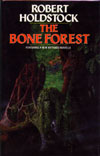
Very good collection, mostly fantasy, yet treading the dark edge of horror, rather than adventure or whimsey. Mostly worth it for the title novella and “Thorn,” but no outright clunkers. In detail:
- “The Bone Forest”–This is a prequel novella to Holdstock’s Mythago Wood and Lavondyss, I believe. It stands alone fine. This reminded me of Jonathan Carroll–what his writing would be like if he allowed himself to lose himself within the fantasy rather than playing on the dividing line between fantasy and “reality” (I read recently that Nabokov recommends always enclosing the word “reality” in quote marks). The mythago idea is a powerful one, and provides plenty of material that Holdstock could work through for years. Yet, he seems to shy away from the epic, instead concentrating on individual stories–mano a mano with the wood. I have to admit that I think that I admire him for that.
- “Thorn”–Another powerful story, this time about a man led into a belief then believed betrayed. And, yet, was he? There’s a sense of both here. That what the man was being led to was right; that what was being done to him was wrong. But was it wrong, or just different? It reminds me of some of the cultural anthropology that I’ve been reading recently–what is one group’s delicacy is another’s abomination. What is moral in one group is highly irregular, if not immoral, in another. Excellent story to bring that out.
- “The Shapechanger”–Nice, yet not as good as the others. First, the good things. Excellent use of pagan magic and relationship between the old shaman and young, inexperienced and somewhat reluctant apprentice. Sense of danger high and yet not silly. But then, as we learn more of the daemon–the child haunting the past from the future–the idea goes downhill. Not necessarily Holdstock’s fault; battered children are, unfortunately, an overused element in today’s fantasy and horror fiction. While this might have been fresh at the time it was written, it appears old hat to us now. Still, the writing and pacing are excellent, and worth reading.
- “The Boy Who Jumped the Rapids”–Didn’t like this one so much…I think because it didn’t seem to complete itself. The elements are all there and fine–conflict, action, meaning–yet it seemed less cohesive than it should. The central mystery, the horned stranger, is resolved, but the secondary mystery, Caylon’s ability to ford the river, seems like it is resolved yet again doesn’t. Maybe it’s the interplay of the two, and trying to figure out what one theme does to the other.
- “Time of the Tree”–Very Borgesian. What it means, I don’t know, but the style, the description, are interesting. The world on man? The Earth as man? Strange–also reminiscent of Garcia Marquez’ story about the beached giant.
- “Magic Man”–Well done pre-history story. I tend not to like Clan of the Cave Bear stories, so it had to get over that bias of mine. Good description, good conflict, and nice twist at the end.
- “Scarrowfell”–Like “Thorn,” a pagan fantasy/horror, playing with the modern reader’s normal Christian assumptions, then removing the veil to show the true meaning. Much of Holdstock’s work dabbles in the pagan–Mythago Wood makes a point that what we perceive as history is just the last link in a long chain of myths. It certainly differentiates his fantasies from those of others.
- “The Time Beyond Age”–This is science fiction; the rest of the book has been fantasy. Yet there’s a similarity here with the fantasy. Again, the focus is on obsession and the need to study something and understand it (as with the title novella), but the very act of studying drives the observer into contact with the phenomena and, ultimately, ruins any chances for objective advancement of knowledge. Basically, it’s the Heisenberg Uncertainty Principle made fictive.
[Finished 15 October 1993]
